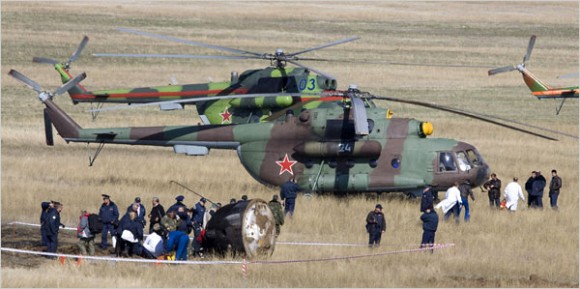As I recall, the Soyuz spacecraft landed in the steppes of Kazakhstan and at a distance of more than 400 km from the destination, a particularly difficult landing during which the astronauts were exposed to 8G, and to the lack of communication capabilities

The first Korean astronaut, Yi Sun-yeon, was hospitalized this week in a hospital in Seoul due to back pain caused by the forced landing of the Soyuz spacecraft that brought her and the two members of the 16th crew of the space station from the station to Earth about two weeks ago.
Crew 16 commander Peggy Whitson said she is confident Russian engineers will locate the source of the malfunction that caused the Soyuz spacecraft to deviate from its orbit during the April 19 landing. At a press conference held in Houston on Friday, Whitson said that independent groups and Russian space agency officials are looking into why the emergency landing of the spacecraft she was traveling in and the previous Soyuz spacecraft that landed last October happened to find the root of the problem and fix it.
NASA Deputy Administrator William Gerstenmeier, who is responsible for manned flights, detailed last week the reasons for the malfunction that caused the ballistic landing of the Soyuz spacecraft in which two members of the 16th crew of the International Space Station and the Korean astronaut were.
According to Gerstenmeyer, due to a technical malfunction and not due to an error by the crew members, the Soyuz capsule did not separate from its propulsion component as planned. The bolt that was supposed to open before entering the atmosphere through the explosion of explosives did not operate in time. This caused the propulsion component and the spacecraft with which the astronauts return to enter the atmosphere before separation. It is still unclear whether the components separated later due to the activation of the explosives or were torn apart due to the high temperatures generated during fast flight through the atmosphere. Gerstenmeier commented that it would have been better if they had forcibly separated after entering the atmosphere and this allowed the manned spacecraft to make an emergency landing. In any case, a "ballistic landing" (as opposed to a planned landing), was the result of this malfunction. According to Gerstenmeier, the spacecraft fell like a bullet from a rifle before the parachutes opened.
Gerstenmeier's report also shows that the team members experienced a gravitational force of 8.2 G, that is, a force of attraction 8.2 times greater than that on the ground. The entry into the atmosphere caused damage to the exit door of the Soyuz due to the angle of impact with the ground. Also, parts outside the heat shield were burned, including the communication antenna was also lost at some point.
NASA confirmed reports from the Russian space agency that there was no communication with the people inside the cabin until cosmonaut Yuri Melanchenko managed to free himself from the cabin and used a satellite phone to contact the control center. This happened about thirty minutes after landing.
Therefore it seems that the emergency landing was extremely successful. As Gerstenmeier said, the design of the Soyuz spacecraft includes built-in reliability. After all, the original design of the manned spacecraft was developed in the 1967s. The first Soyuz spacecraft was launched in 99, and since then 11 missions have been carried out (including 2002 since 2010). The importance of the Soyuz and Progress spacecraft (Russian cargo spacecraft of a similar design, except that they are unmanned) is already great today for the functioning of the International Space Station and will increase even more after the American space shuttles are taken out of service in 2015. The next generation spacecraft, the Orion model, is not planned for launch before XNUMX, so that there will be a gap of five years that will have to be filled. NASA is looking at commercial options, but the old and reliable Soyuz remains the best option.
The international space community hopes that the technical fault will be investigated and that subsequent returns of Soyuz spacecraft from orbit will be better managed.

2 תגובות
Another rape investigation?